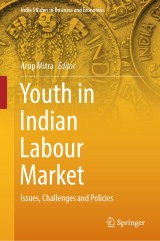Details

Youth in Indian Labour Market
Issues, Challenges and PoliciesIndia Studies in Business and Economics
|
160,49 € |
|
| Verlag: | Springer |
| Format: | |
| Veröffentl.: | 20.03.2024 |
| ISBN/EAN: | 9789819703791 |
| Sprache: | englisch |
Dieses eBook enthält ein Wasserzeichen.
Beschreibungen
<p>This book addresses labour market participation issues of youth in India, and follows an inter-disciplinary approach. It carries out both quantitative and qualitative assessments for an in-depth understanding of these issues. It collates a wide range of concerns both from supply and demand side, and instead of reflecting on the empirical questions only, the book reflects on various analytical questions as well. Some other challenges being discussed here are inadequacy of skill and compulsion to participate in the labour market, concentration in activities with excess supplies of labour, unrecognised work experience, lack of upward mobility, and working with information asymmetry. Caste and gender disadvantages are an instrumental part of the book. Problems of educated and uneducated youth are quite different and the book analyses them separately. Besides, it refers to a wide range of issues relating to occupational flexibility. It also discusses skill imparting institutions and themajor lacuna associated with their functioning. Social unrest and threats to the prospects of future growth in the absence of adequate youth employment are some of the economic and political issues which the book covers. Unraveling the threads of the concerns mentioned above, the book finally comes up with policy suggestions. It is a great resource for researchers, industry watchers, and policy makers who are interested in inclusive and sustainable growth.<br></p>
<p>Introductory.- A global perspective on youth employment challenges: what have we learned over the last two decades?.- Labour Market Profile of the Youth: Role of Education, Caste and Economic Background.- Youth and challenges in Contemporary World of Work in India.- Employment Vulnerability among Young Indian Workers.- Status of Youth’s Employment in Uttar Pradesh: Demographic Dividend or Disaster.- Post-school Experiences of the Youth: Tracing Delhi Slum Dwellers from 2007/08 to 2018.- Youth Employment in India: The Female Perspective.- The Challenge of Youth Employment in India: A Gender Perspective.- Labour productivity of Rice crop in India: A comparison between Agriculture in Eastern and Western Regions.</p>
<p>Arup Mitra is Professor of Economics at the South Asian University, New Delhi. Before that, he was affiliated to the Institute of Economic Growth, Delhi. His research interest includes issues in the area of urban development, labour and welfare, industrial growth and productivity and gender inequality. He has published in a number of international and national journals. He worked as a senior researcher at ILO (Geneva), was offered visiting fellowship at Institute of Developing Economies (Tokyo) and held the Indian Economy Chair at Sciences Po. (Paris). The Indian Econometric Society offered him the Mahalanobis Award for his outstanding contribution in the field of quantitative economics. His work has been cited in the Hand Book of Regional and Urban Economics, and he has also contributed in the Encyclopaedia of Life Support Systems (EOLSS) and Mathematical Models in Economics (Ed. Zhang, W.), developed under the auspices of the UNESCO.</p>
This book addresses labour market participation issues of youth in India, and follows an inter-disciplinary approach. It carries out both quantitative and qualitative assessments for an in-depth understanding of these issues. It collates a wide range of concerns both from supply and demand side, and instead of reflecting on the empirical questions only, the book reflects on various analytical questions as well. Some other challenges being discussed here are inadequacy of skill and compulsion to participate in the labour market, concentration in activities with excess supplies of labour, unrecognised work experience, lack of upward mobility, and working with information asymmetry. Caste and gender disadvantages are an instrumental part of the book. Problems of educated and uneducated youth are quite different and the book analyses them separately. Besides, it refers to a wide range of issues relating to occupational flexibility. It also discusses skill imparting institutions and the major lacuna associated with their functioning. Social unrest and threats to the prospects of future growth in the absence of adequate youth employment are some of the economic and political issues which the book covers. Unraveling the threads of the concerns mentioned above, the book finally comes up with policy suggestions. It is a great resource for researchers, industry watchers, and policy makers who are interested in inclusive and sustainable growth.
Analyses in detail the employment profile of youth, reflecting on analytics as well as empirics Focuses on constraints relating to demand for labour and reflects on poor employability of youth Recommends policies in the light of findings and suggests initiatives which can empower youth in the labour market
Diese Produkte könnten Sie auch interessieren:

The Impact of Inflation and Monetary Policy Shocks on Stock Market Performance in Zimbabwe

von: Mkhululi Ncube

29,99 €
















